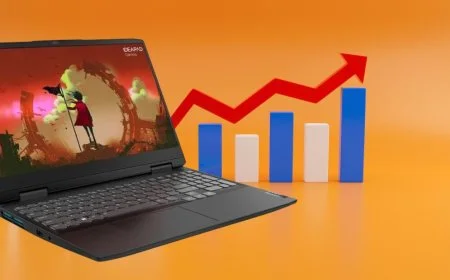When Lenovo Purchased IBM: The $1.75 Billion Deal That Shaped Tech History
Discover when Lenovo bought IBM and explore the acquisition's impact on the tech world and Lenovo's rise!

In 2005, a major shift occurred in the technology industry when Lenovo purchased IBM’s Personal Computing Division. This acquisition made waves across the global market, as Lenovo transitioned from being a primarily Chinese brand to becoming a key player on the international stage. The deal was significant, not just for the two companies involved, but for the entire PC industry, reshaping competition and product innovation. This article delves into the details of when Lenovo purchased IBM, what it meant for both businesses, and its impact on the tech world.
Lenovo purchased IBM’s Personal Computing Division in 2005 for approximately $1.75 billion. This deal included IBM’s ThinkPad line, which had a strong reputation in the business world for its reliability and performance. For Lenovo, this acquisition provided instant credibility and a foothold in the global PC market.
By acquiring IBM’s PC division, Lenovo became the world’s third-largest computer manufacturer almost overnight. This was a game-changer, enabling Lenovo to blend its manufacturing strength with IBM's established brand. Today, Lenovo is a global tech leader, with the ThinkPad series still widely recognized and used.
Tips for Understanding the Deal:
- Focus on Numbers: Lenovo paid $1.25 billion in cash and $500 million in assumed debt.
- Brand Impact: The ThinkPad line became one of Lenovo's strongest assets.
- Global Expansion: This purchase marked Lenovo’s entry into global markets.
Wondering how this historic acquisition reshaped the tech landscape? Continue reading to uncover the lasting effects of Lenovo's purchase of IBM and how it positioned Lenovo as a powerhouse in the global market. Whether you're a tech enthusiast or someone curious about corporate acquisitions, this article provides valuable insights.
Before the Acquisition
Alright, let's take a trip back to a time when DVDs were still a thing, and no one had heard of TikTok yet. Understanding the state of things before Lenovo gobbled up IBM's PC business gives us some juicy context for how big a deal this was. Here, we’ll check out what Lenovo looked like before 2005 and see what was happening with IBM's PCs.
Lenovo's Position Pre-2005
Let’s rewind to pre-2005. Back then, Lenovo was like a scrappy underdog in the global PC fight—holding onto the #9 spot. With a modest 2.3% market share and around $3 billion in annual revenue, most of its action was happening in China. They weren’t really swinging for the fences on the global stage yet.
| Year | Market Share | Annual Revenue |
|---|---|---|
| 2005 | 2.3% | $3 Billion |
| 2015 | 20% | $39 Billion |
Fast forward to post-acquisition glory: Lenovo became the #1 PC maker worldwide by 2015. Talk about a glow-up! This major move didn't just shuffle their market share; it rocketed them to the top, allowing them to flag down more significant pieces of the pie.
IBM's PC Business Stats
Now, what about IBM? Before handing over its PC division, IBM had a lot going for it in the PC market but was itching to focus on more lucrative areas like software and services. Selling its PC biz was a big pivot, not just for IBM but also for Lenovo. For Lenovo, snapping up IBM's PC division was like getting a cheat code. They instantly gained a respected brand and a loyal customer base. It's like going from riding a bike to zooming in a sports car—global street cred included.
The sale virtually transformed Lenovo overnight, expanding its portfolio and credibility in one big swoop.
Craving more Lenovo magic? Check out how to make your Lenovo laptop zip through tasks like a champ with our guide on speeding up your Lenovo laptop. Or, if you need some security tips, find out how to remove a password from your Lenovo laptop. Dive in and discover the potential of Lenovo gear today!
Transition and Growth
Buying IBM's PC biz in 2005 totally shook things up for Lenovo, launching them right into the big leagues.
Lenovo After the Big Move
After sealing the deal with IBM, Lenovo wasted no time becoming the top dog in the PC world, holding onto the No. 1 spot for over ten years. With IBM's goodies in hand, Lenovo pumped up their products, especially the famous Think brand. They didn't just sit on the couch either; they poured cash into research and development to cook up a bunch of new stuff.
| Year | Revenue (Billion USD) | Key Achievement |
|---|---|---|
| 2005 | 13.0 | Bought IBM's PC business |
| 2010 | 21.0 | Became the world's top PC seller |
| 2015 | 46.0 | Jumped into the smartphone and tablet game |
| 2020 | 50.7 | Broadened into servers and more tech gadgets |
Lenovo didn’t just make money; they bagged a ton of awards and pats on the back for their designs and products, proving they were serious about staying ahead (Lenovo Newsroom).
Lenovo’s Market Adventure
Nailing the IBM deal opened up a world of opportunities for Lenovo. They jumped into making smartphones, tablets, and even servers, covering more bases than a baseball team. Since the IBM buy, Lenovo's made eight smart buys, putting themselves in the fast lane for growth and profit (Lenovo Newsroom).
This hustle didn't just keep them on top in the PC game. It also allowed Lenovo to build a thriving network around their tech, meaning they're not just famous for laptops anymore. They turned heads across different tech markets with a lineup that can give any tech giant a run for their money.
Through all the twists and turns, Lenovo stayed on their toes, meeting customer needs and going global in a big way. Fancy knowing how to fix a tricky Lenovo issue? Check out these tips on how to speed up my Lenovo laptop or how to start a Lenovo laptop in safe mode.
Power Partnerships
The Lenovo and IBM Tag Team
When Lenovo teamed up with IBM, it wasn't just your average handshake deal—it was a game-changer. After Lenovo scooped up IBM's PC division, they didn't just walk away with some cool new toys. They formed a solid alliance where Lenovo PCs hit the market through IBM's well-oiled distribution and sales machine. This let Lenovo show off its shiny gadgets to pretty much the whole world. IBM played the role of the big brother here, not only lending services and financing but also giving Lenovo's name some serious street cred.
This partnership was a win-win; Lenovo got to strut its stuff to IBM's massive customer base, and IBM spiced up its lineup with Lenovo's cutting-edge tech.
| Partnership Perk | What It Means |
|---|---|
| Marketing | Lenovo's gear sold through IBM's vast network |
| Services | IBM handles the service and financing side of things |
| Product Line | Lenovo becomes IBM's go-to for PCs |
Lenovo's Glow-Up
Hooking up with IBM had Lenovo leveling up in all sorts of ways. Tapping into IBM's unbeatable infrastructure, Lenovo broke into markets faster than a kid on Christmas morning. After snagging IBM's PC business, Lenovo went all-in on R&D like it was the Super Bowl of innovation. They didn't just stop at better laptops—they branched out into workstations, servers, tablets, and convertibles, turning the "Think" series into a symbol of tech royalty.
The "Think" brand, originally an IBM gem, became Lenovo's crown jewel, winning over 2,600 awards and turning heads in the tech world.
Lenovo didn't just stop at making cool gadgets; they also beefed up their customer service and financing options, thanks to their BFF IBM. This combo of cutting-edge products and killer customer support helped Lenovo solidify its spot at the top of the global PC scene.
Caught up with Lenovo tech? Check out our guides on how to start your Lenovo laptop in safe mode and tackle any hiccups with ease.
Concerns and Issues
When Lenovo snatched up IBM back in 2005, folks—especially those in the government and tech world—got pretty jittery. The big question was: what happens when tech secrets head over to China?
U.S. Government Concerns
Top of the list was the worry about advanced tech and valuable company secrets landing in Lenovo’s lap. Lenovo’s got some tight links to the Chinese Academy of Sciences, which is run by China's top brass, the State Council. That cozy relationship made folks uneasy, thinking maybe some U.S. government contracts could end up getting handled by Lenovo, or even Beijing itself (Computerworld).
Once Lenovo scooped up IBM’s PC division, people started to question if the U.S. government would need to give a thumbs-up for Lenovo to operate. There was a real fear that blocking parts of the deal might leave Lenovo trailing behind heavyweights like Dell and HP (Computerworld).
Deal Evaluation Challenges
Figuring out the impact of the Lenovo-IBM deal wasn’t a walk in the park. The tech involved was complex, and the deal itself was massive. Lenovo wasn’t just buying a company; it was buying a ticket to the big league, suddenly becoming the third-biggest name in personal computing (Lenovo News).
The U.S. government had to weigh the pros and cons of this new IT behemoth. On one hand, it meant more competition and potentially better prices and products for consumers. On the other hand, it stirred up concerns over tech secrets and national security. The spotlight was on this deal, reflecting how tangled up technology, global business, and national security can get.
For more on fixing those pesky Lenovo product issues, you might check out handy links like how to start Lenovo laptop in safe mode, how to unlock touchpad on Lenovo laptop, and how to enable Bluetooth in Lenovo laptop.
Money Matters
What Went Down
When Lenovo bought IBM's PC business, it was a big splash in the tech pool. Announced on December 8, 2004, the deal came with a price tag of US$1.75 billion. This hefty sum had US$1.25 billion in cash and equity, while IBM also ended up with an 18.9% stake in Lenovo (Lenovo Press Release).
| Part of the Deal | Value |
|---|---|
| Total Cost | $1.75 billion |
| Cash and Equity | $1.25 billion |
| IBM's Land Share | 18.9% |
They aimed to wrap it up by mid-2005. Some folks were jittery about transferring top-notch tech and resources, especially with whispers about the Chinese government’s slice in Lenovo (Computerworld).
Cash In, Growth Up
Post-buy, Lenovo started hitting big. By tapping into IBM's strong marketing and services network, they reached more customers and got their name out there. Their revenue shot up as they mixed IBM’s well-known PC stuff into their own lineup, basking in IBM's brand glow and wide distribution.
| Year | Revenue Guess |
|---|---|
| 2005 | $13 billion |
| 2006 | $19 billion |
| 2007 | $22 billion |
This leap forward didn’t just fatten Lenovo's wallet; it also pinned them as a top dog in the worldwide PC market. Plus, IBM still played the part of go-to service and finance guru, boosting Lenovo's game (Lenovo News).
As Lenovo continues to stride ahead in the tech groove, the financial ripples from buying IBM’s PC arm show just how clever that move was.
Long-Term Impact
Lenovo's Technological Evolution
Since picking up IBM's PC business, Lenovo's tech game has evolved big time. Plugging into IBM’s know-how supercharged Lenovo's products, making their laptops, smartphones, and servers way better. This jump in tech set them up to break into some pretty juicy markets and flip their business strategy on its head.
After that acquisition, Lenovo kept the ball rolling with eight more buyouts, making gains not just with PCs but also with mobile devices and enterprise solutions. This mix-and-match of different tech sectors has made Lenovo a standout in the market, letting them adapt smoothly to shifts in the industry.
| Year | Big Move | What's Affected |
|---|---|---|
| 2005 | Grabbing IBM's PC Business | PCs |
| 2010 | Picking Up Medion | Consumer Electronics |
| 2014 | Snagging Motorola Mobility | Smartphones |
| 2016 | Buying IBM's Cloud Unit | Cloud Services |
Legacy of the Acquisition
Lenovo buying IBM's PC business was a game-changer with long-lasting effects. It flipped Lenovo's role from being a local player to a global tech superstar, shaking up the whole computer industry. Their wider product range and non-stop innovation have set new high bars in this field.
This move also let Lenovo get serious about building their tech ecosystem. Bringing successful buyouts into the fold didn't just mean more gadgets—it meant better services tuned to what users actually want. This approach has paid off in spades by improving user experience and reliability.
This buyout is a textbook case of how merging with a big name can steer a company in a new direction, especially in tech where the latest and greatest rule the roost. Curious about Lenovo's history? Check out where is Lenovo located or dig into what Lenovo means.
Lenovo's tie-in with IBM stands out as a landmark moment in tech mergers, showing how one smart business move can remake a company's future.
Final Thoughts: When Lenovo Purchased IBM
When Lenovo purchased IBM in 2005, it was more than just a corporate transaction—it was a pivotal moment in the evolution of the tech industry. The acquisition allowed Lenovo to gain instant recognition in the global market, thanks to IBM's established reputation. The ThinkPad series, an asset from the deal, continues to thrive today, demonstrating the long-lasting impact of this move. Lenovo’s success story is a testament to how strategic acquisitions can shape the future of a company and the industry at large.
FAQs about When Lenovo Purchased IBM
Q: Why did Lenovo purchase IBM’s PC division?
A: Lenovo purchased IBM’s Personal Computing Division in 2005 to gain access to global markets and strengthen its product portfolio. IBM’s PC division, especially its ThinkPad line, had a strong brand presence, which helped Lenovo become a key player in the global PC market almost instantly.
Q: How much did Lenovo pay to purchase IBM?
A: Lenovo paid approximately $1.75 billion to acquire IBM’s PC division. This included $1.25 billion in cash and $500 million in assumed debt. The purchase allowed Lenovo to leverage IBM’s established brand and expand globally.
Q: What was the impact of Lenovo’s purchase of IBM on the PC industry?
A: Lenovo’s acquisition of IBM reshaped the PC industry by creating a new major player. The ThinkPad series, acquired in the deal, remains one of Lenovo’s best-known products, and Lenovo quickly rose to become one of the largest PC manufacturers globally.
Q: What happened to IBM after the sale of its PC division?
A: After selling its PC division to Lenovo, IBM shifted its focus to higher-margin services and technology solutions, including cloud computing, artificial intelligence, and consulting services. IBM no longer manufactures personal computers but continues to be a key player in enterprise solutions.
Q: Is the ThinkPad series still associated with IBM?
A: While IBM originally created the ThinkPad series, Lenovo owns and produces it today. The ThinkPad has retained its reputation for quality and reliability, continuing to serve business users worldwide under Lenovo’s ownership.
Q: How did Lenovo benefit from acquiring IBM’s PC division?
A: Lenovo benefited greatly from acquiring IBM’s PC division. The acquisition gave Lenovo instant brand recognition in the global market, access to new customers, and a product line with a strong reputation, such as the ThinkPad series. This deal positioned Lenovo as a major player in the global PC industry.
What's Your Reaction?







































![MacBook Pro M5: All the features and specs you need to know [LEAKS REVEALED]](https://tomsreviewbox.com/uploads/images/202502/image_430x256_67bd6d7cd7562.jpg)




























